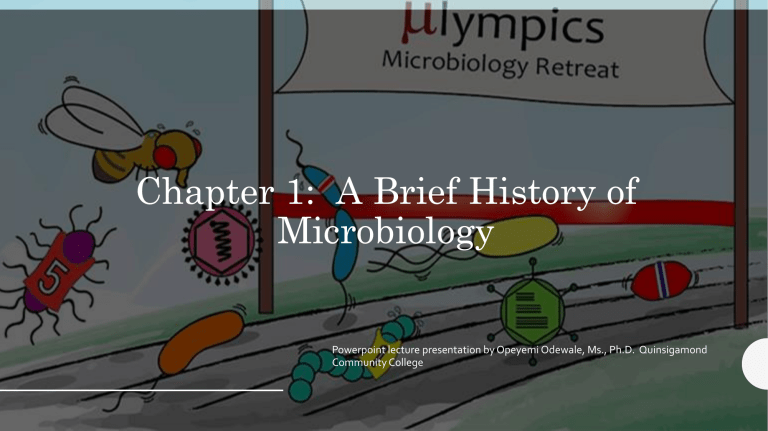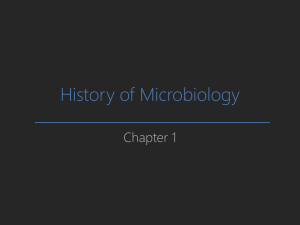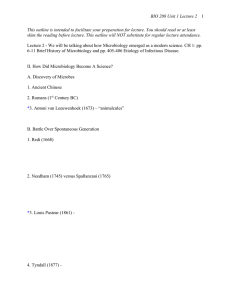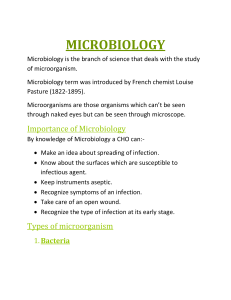
Chapter 1: A Brief History of Microbiology Powerpoint lecture presentation by Opeyemi Odewale, Ms., Ph.D. Quinsigamond Community College The Early Years of Microbiology • In this section we – Describe the world-changing scientific contributions of Leeuwenhoek. – Define microbes in the words of Leeuwenhoek and as we know them today. – List six groups of microorganisms. – Explain why protozoa, algae, and nonmicrobial parasitic worms are studied in microbiology – Differentiate prokaryotic from eukaryotic organisms. Microbiology & health science correlation • Microbiology & health science correlation • Infection control (IC) weighting by domain – Standard precautions and the prevention of disease transmission (20%) – Prevention of cross-contamination during procedures (34%) – Instrument/device processing (26%) – Occupational safety/administrative protocols (20%) • Microbiology & health science correlation Microbiology & health science correlation Microbiology & health science correlation The Early Years of Microbiology • What is microbiology • Study of living organisms too small to be seen with the unaided eye and the effects they cause – Micron (µm) = small – Biologia = study of life The Early Years of Microbiology • Units of measurements (unit of length or width) – Metric system • • Metric system is the internationally agreed upon system of measurements • A measurement system of prefix based on multiples of tens (1/10th) Microorganisms are measured in micrometers (μm) and nanometers (nm) • 1 µm (micrometer) = 1/100,000 or 10–6 – 10–6 μm= 0.0000001 m (prokaryotic & eukaryotic pathogens ) • 1 nm (nanometer) = 1/100,000,000 or 10–9 m – 10–9 nm=0.0000000001 m (prokaryotic & viral pathogens) The Early Years of Microbiology • What Does Life Really Look Like? – Antoni van Leeuwenhoek • 1632-1723 • Contribution to field of microbiology – First known scientist that made and used simple microscopes to observe microorganism (i.e. bacteria) – Often made a new microscope for each specimen – Examined water and visualized fungi, algae, and unicellular protozoa; "animalcules“ (tiny animals) – By end of 19th century, these organisms were called microorganisms The Early Years of Microbiology • How Can Microbes Be Classified? – Carolus Linnaeus developed a taxonomic system for naming and classification methods organisms (microorganisms) – Naming system (nomenclature) • Binomial nomenclature – Genus name (first-name): group marked by common characteristics – Species name (last name): group marked by individuals capable of reproducing • Example: S. aureus or S. aureus (Staphylococcus aureus) – Linnaeus’ classification system grouped organisms into “2 Kingdoms” which include animal or plants: – Current classification scheme “ 3 Domains” developed by Carl Woese & George Fox • • • Prokaryotes – Bacteria – Archaea Eukaryotes – Fungi (Mycology) – Algae (Phycology) – Small unicellular animals (Protozoa) (parasitology ) – Small multicellular animals (Helminths) (parasitology) Virus & Prions ** – Visualized with an electron microscope The Early Years of Microbiology The taxonomic classification hierarchy – There is a hierarchy of groups (taxa) from general to specific • 8 Levels of Classification – Domain Do (modern) General taxon – Kingdom Kings (earliest) – Phylum Play – Class Chess – Order On – Family Fine – Genus Glass – Species Slates Specific taxon The Early Years of Microbiology How can microorganisms be classified? Prokaryotes Eukaryotes Animal Bacteria & Archaea Plant Fungi Algae Parasites The Early Years of Microbiology • How Can Microbes Be Classified? – Prokaryotes (Bacteria and Archaea) • • Characteristics: – Bacteria primarily inhabit locations where there is sufficient nutrients/moisture (i.e. normal flora aka microbiota) – Archea inhabit extreme environments (i.e. (i.e. acidic hot springs, swamp mud & Great Salt Lake) – Cellular morphology: unicellular Genetic material: circular dsDNA – Extrachromosomal material: plasmid & bacteriophage • Reproduction: asexually (binary fission, etc.) • Bacterial cell walls are composed peptidoglycan – • Some bacteria lack cell walls (i.e. Mycoplasma cause of Walking pneumonia) Archaeal cell walls are composed of pseudomurein The Early Years of Microbiology • How Can Microbes Be Classified? – Eukaryotes • Fungi – Eukaryotic: membrane-bound nucleus & organelles – Heterotrophs- obtain food from other organisms (differentiates them from plants (autotrophs)) – Reproduction: sporulation form of asexual reproduction; sexual – Possess cell walls :differentiates them from animals: – Include: • Molds — multicellular; grow as long filaments; reproduce by sexual and asexual spores, 25 degrees Celsius • Yeasts — unicellular; reproduce asexually by budding; some produce sexual spores, 37 degree Celsius • Dimorphic fungus: unicellular/multicellular, 25 & 37 degree Celsius The Early Years of Microbiology • How Can Microbes Be Classified? – Eukaryotes • Unicellular parasite (Protozoa) – Similar to animals in nutritional needs and cellular structure “first animals” – Live freely in water; some live in animal hosts – Asexual (most) and sexual reproduction – Categories of protozoa based on locomotion: • Pseudopods — extensions of the cell that allow for flow-like movement (i.e. plasmodium) • Cilia — short protrusions of the cell, that allow for propulsion movement (Paramecium) • Flagella — long extensions of a cell, that allows for whiplike movement (i.e. Giardia) • Non-motile –(i.e. amoeba) The Early Years of Microbiology • How Can Microbes Be Classified? – Eukaryotes • Multicellular parasites (Helminths “worms”) • Not strictly microorganisms, however some microscopic stages in their life cycles – Two major groups of parasitic worms (helminths) • Flatworms • Roundworms The Early Years of Microbiology • How Can Microbes Be Classified? – Eukaryotes • Algae – Unicellular or multicellular – Photoautotrophs – Categorized on the basis of – Pigmentation: Red, green and brown algae – Cell wall structure (cellulose, silica, etc. ) – Subgroup of algae • Diatom • Dinoflagellates • Watermold The Early Years of Microbiology • How Can Microbes Be Classified? – Other Organisms of Importance to Microbiologists • Viruses – Characteristic: obligatory intracellular acellular parasites due to their use of host machinery – Genetic material: DNA or RNA – Morphology: – • Protein coat (capsid) • Envelope or non-enveloped Microscopy: • Visualization requires electron microscopes The Golden Age of Microbiology • In this section we – List and answer four questions that propelled research in what is called the “Golden Age of Microbiology.” – Identify the scientists who argued in favor of spontaneous generation. – Compare and contrast the investigations of Redi, Needham, – Spallanzani, and Pasteur concerning spontaneous generation. – List four steps in the scientific method of investigation. – Discuss the significance of Pasteur’s fermentation experiments to our world today. – Explain why Pasteur may be considered the Father of Microbiology. – Identify the scientist whose experiments led to the field of biochemistry and the study of metabolism. – List at least seven contributions made by Koch to the field of microbiology. – List the four steps that must be taken to prove the cause of an infectious disease. – Describe the contribution of Gram to the field of microbiology. – Identify six health care practitioners who did pioneering research in the areas of public health microbiology and epidemiology. – Name two scientists whose work with vaccines began the field of immunology. – Describe the quest for a “magic bullet.” The Golden Age of Microbiology • Does Microbial Life Spontaneously Generate? – Some philosophers and scientists of the past thought living organism (or microorganism) arose from three processes: • Biogenesis theory – Asexual reproduction (biogenesis) – Sexual reproduction (biogenesis) • Spontaneous theory – Nonliving matter (abiogenesis) – Aristotle, a Macedonian philosopher • 384-322 B.C. • Contribution to field of biology: proposed that life (living matter) arises from nonliving matter (supports spontaneous generation) The Golden Age of Microbiology • Does Microbial Life Spontaneously Generate? – Francesco Redi, an Italian physician • 1626-1697 • Redi's Experiments (against spontaneous generation) – Contribution to field of biology: Proposed that living matter arose from other living matter • Isolated (sealed) decaying meat from flies→ No maggots → No flies • Exposed decaying meat to flies→ Maggot formation→ New progeny of flies The Golden Age of Microbiology • Does Microbial Life Spontaneously Generate? – John T. Needham, British investigator • 1713-1781 • Needham's experiments (support spontaneous generation) – Contribution to field of microbiology: Proposed that microorganism arose from nonliving matter • Boiled beef gravy and infusions of plant material in an opened vial, which he later sealed • Observed cloudiness within the vial → microorganisms The Golden Age of Microbiology • Does Microbial Life Spontaneously Generate? – Lazzaro Spallanzani, Italian Catholic priest & scientist – 1729-1799 – Spallanzani's experiments (against spontaneous generation) • Contribution to the field of microbiology: – Concluded that Needham failed to heat vials sufficiently to kill all microbes or had not sealed them tightly enough – Microorganisms exist in air (airborne microorganism) – Spontaneous generation of microorganisms does not occur; all living things arise from other living things The Golden Age of Microbiology • Does Microbial Life Spontaneously Generate? – Louis Pasteur, French chemist and microbiologist “Father of Microbiology” – 1822-1895 – Pasteur's Experiments (against spontaneous generation) • Contribution to field of microbiology: cemented the theory of biogenesis (living organism arising from living organism) – Boiled beef infusion in an upright "swan-necked" flasks→ no microbial growth – Tilted swan-necked flask & broke neck of neck of swan flask→ microbial growth – Concluded microbes are present in the air (airborne microbes) The Golden Age of Microbiology • Does Microbial Life Spontaneously Generate? – Needham, Redi, Pasteur, Spallanzani experiments were performed without use of scientific method – The Scientific Methods • Provides a framework for conducting an experiment • Steps of Scientific Method – Observation – Generates a hypothesis—that is, a potential answer to the question – Designs and conducts an experiment to test the hypothesis – Data analysis – Based on the observed results of the experiment, the scientist either accepts, rejects, or modifies the hypothesis • Accepted hypotheses that explain many observations and are repeatedly verified by numerous scientists over many years are called theories or laws The Golden Age of Microbiology • What Causes Fermentation? – – Fermentation: conversion of sugar to alcohol in the absence of air • Bacteria that use alcohol as a source of energy, spoil wine by turning it to vinegar (acetic acid) • Spoiled wine threatened livelihood of many grape growers. Wine makers funded research by Pasteur, to investigate spoilage of wine Pasteur Applied the Scientific Methods in Investigating Fermentation • Pasteurization: process of heating liquids enough to kill most bacteria, therefore bacteria that spoil wine could be killed via pasteurization • Concluded a correlation between pathogen and wine-spoilage → Germ Theory of Disease The Golden Age of Microbiology • What Causes Fermentation? – Eduard Buchner, German biochemist , 1860-1917 – Buchner's Experiments • Contribution to the field of science: began field of biochemistry, through understanding of enzymatic activities “Father of biochemistry” • Demonstrated fermentation does not require living cells, but enzymatic activity The Golden Age of Microbiology • What Causes Disease? – Germ theory of disease • Formulated by Louis Pasteur & Robert Koch • States that pathogenic microorganisms (pathogens) causes disease • Pathogens: disease-causing microorganisms – Note: theory only applies only to infectious disease The Golden Age of Microbiology • What Causes Disease? – Robert Koch , “Father of Etiology” German physician, 1843-1910 • Contribution to field of microbiology: Advanced field of disease etiology through studies that included but not limited to – Proposal of Koch’s postulates of germ theory – Use of Petri dish – Development of staining techniques – Isolation of bacteria (B. anthrax, M. tuberculosis and V. cholera The Golden Age of Microbiology • What Causes Disease? – Koch’s Postulates • Principle: Criteria designed to establish disease etiology • Steps of Koch’s Postulates 1. Suspected causative agent must be found in every case of the disease and be absent from healthy hosts 2. Agent must be isolated and grown outside the host 3. When agent is introduced to a healthy, susceptible host, the host must get the disease 4. Same agent must be found in the diseased experimental host The Golden Age of Microbiology • What Causes Disease? – Gram's Stain • Han Christian Gram, Danish scientist, 1853-1938 • Contribution to field of microbiology: enhanced staining technique which allow bacterium to be differentiated into Gram (+) or Gram (-) – Gram-positive bacteria have thick peptidoglycan cell walls – Gram-negative bacteria have thin peptidoglycan cell walls and a layer of lipopolysaccharides The Golden Age of Microbiology • How Can We Prevent Infection and Disease? – Health care practitioners instrumental in changing the way health care is delivered • Ignaz Semmelweis, Austrian physician, 1818-1865 – Contribution to the health-care field: Pioneered practiced of handwashing with chlorinated lime solutions in obstetrical clinics in healthcare setting The Golden Age of Microbiology • How Can We Prevent Infection and Disease? – Health care practitioners instrumental in changing the way health care is delivered • Joseph Lister, British surgeon, 1827-1912 • Contribution to the health-care field: Pioneered use of antiseptic (carbolic acid (phenol)) surgery in healthcare setting – Antiseptic: chemical agent used on living tissue to destroy vegetative pathogen – Disinfectant: chemical agent used on inert objects and/or surface (i.e. tabletop) to destroy vegetative pathogens The Golden Age of Microbiology • How Can We Prevent Infection and Disease? – Health care practitioners instrumental in changing the way health care is delivered • Florence Nightingale, British nurse, 1820-1910 • Contribution to the healthcare field: Pioneered field of nursing education, public health policies and statistical evidence for disease etiology – Nightingale is known as "the founder of modern nursing.“ Nightingale was the leader in advocating that nurses receive formal education and training – Nickname: "The Lady of the Lamp" "The Lady with the Pie Chart" The Golden Age of Microbiology • How Can We Prevent Infection and Disease? – Health care practitioners instrumental in changing the way health care is delivered • John Snow, English physician, 1813-1858 • Contribution to the health-care field: pioneered the field of infection control and epidemiology • Mapped the cause of water-born disease, caused by V. cholera, to a commonly used water-well The Golden Age of Microbiology • How Can We Prevent Infection and Disease? – Health care practitioners instrumental in changing the way health care is delivered • Edward Jenner, English physician, 1749-1823 • Contribution to the health-care field: Pioneered field of immunology & immunization (vaccination) • Inoculated healthy-patient with Cowpox, in order to prevent Smallpox The Golden Age of Microbiology • How Can We Prevent Infection and Disease? – Health care practitioners instrumental in changing the way health care is delivered • Paul Ehrlich, German microbiologist, 1854-1915 • Contribution to the field of microbiology: Pioneered the field of antimicrobial chemotherapy “Magic Bullet”, the concepts of specific microbes can be kill with a specific chemical without harming the body • 1st magic bullet “Salvarsan” chemical used to treat syphilis The Golden Age of Microbiology • How Do We Defend Against Disease? – Chemotherapy: synthetic and/or natural chemical to treat of disease with chemicals • • Natural chemotherapeutics (i.e. antibiotics) – Natural chemotherapeutics drugs are produced naturally by microorganisms (i.e bacteria, fungi, bacteriophage) that inhibit or kill other microbes – 1929: Alexander Fleming discovered Penicillium fungus (i.e. penicillin) to treat S. aureus bacterial infections Synthetics chemotherapeutics – Synthetic chemotherapeutics drugs prepared from chemicals – 1910: Ehrlich discovered quinine drugs (i.e salvarsan, quinine, etc.) to treat T. pallidum bacterial infections (i.e. cause of syphilis) – 1935: Gerhard Domagk discovered sulfa drugs against bacterial infections The Golden Age of Microbiology • How Can We Prevent Infection and Disease? – Health care practitioners instrumental in changing the way health care is delivered • Rebecca Lancefield – Scottish-American microbiology, classified streptococci according to serotypes (variants within a species) • Ruth Ella Moore: African-American bacteriologist, advance the study of blood groups and enterobacteriaceae • William Hinton: African-American microbiologist, developed diagnostic test for syphilis “Hinton test” • Sarah Stewart: Mexican-American microbiologist, discovered polyomavirus, group of virus associated with cancer The Modern Age of Microbiology • How Do We Defend Against Disease? – Body’s Natural Defense • Serology: study of blood serum – • Pioneered by Emil von Behring and Shibasaburo Kitasato — existence in the blood of chemicals and cells that fight infection Immunology – The study of the body's defenses against specific pathogens which includes • • Innate immunity – Mechanical barriers (i.e. skin, mucous membrane) – Chemical (saliva, tears) – Process (inflammation, complement proteins, cells, etc.) Adaptive immunity – B-cells & T-cells • B=Bone marrow • T=Thymus Reference Bauman, R. (2014). Microbiology with Diseases by Taxonomy. 5th edition. Pearson. Black, G. (2011). Microbiology : principles and explorations. 8th ed. Wiley. Tortora, G.J. (2014). Microbiology : an introduction. 12th ed. Pearson. Guess we are not alone after all! Micro-man in charge ☺





